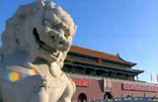Hurdles have to be removed for China's food security
Updated: 2015-02-16 08:24
By Zheng Fengtian(China Daily)
|
|||||||||||
The No 1 Central Document once again highlights the importance of modernizing agriculture. But many obstacles have to be overcome before agriculture can be truly modernized.
Since the costs of many agricultural products are higher in China than in overseas markets, imports are preventing the optimum consumption of domestic products. Confounding this problem is the continuous rise in the costs of raw materials and labor.
Wasteful production methods are aggravating the problem of resource shortages; excessive use of pesticides and fertilizers is contaminating soil and water, compromising the quality of arable land; and underground water tables are being depleted quickly because of unrestricted use of water.
Besides, with the continued migration of working-age people from rural areas to cities, mostly elderly people have to do farm work, which is harming agricultural production. And imbalanced resource allocation has been increasing the cost of agricultural production. A large part of China's arable land is in the Yangtze and Pearl river delta regions, with abundant water resources whereas the north and western regions are troubled with shortages of water. As the grain production base moves to the north, the transportation of food to the south and water to the north has become very costly.
These are major problems, and to tackle them, the authorities have to change the structure and production methods of agriculture.
To begin with, while evaluating agricultural products, the authorities should also take into account the environmental cost - as opposed to the current practice of deciding the price on the basis of input and output alone. Every fall, media outlets are full of news about bumper harvests. But the overemphasis on output encourages higher outputs at the cost of the environment, and local agricultural departments go all out to achieve the production goals set by their governments.
For instance, the success of the pork industry in Jiaxing in Zhejiang province is measured mainly by the number of pigs produced without taking into account the water pollution it causes. This has to change, by, for example, shifting pig farms to sparsely populated areas and compelling them to follow high environmental standards.
Second, the way agricultural subsidies are provided has to change. There has been a substantial increase in agricultural subsidies over the past decade with a view to increasing production, which should not be the aim.
Subsidies for machinery, for example, should be given only to farmers who use machinery, since farming is still done mostly by households on a small scale in China. Hence, instead of giving every farming family a set of machines, the government could offer them prepaid vouchers to rent the machinery they need. This practice used by most of the developed countries is one China needs to adopt.
Another worrying development is that the use of fertilizers in China is increasing at a faster rate than that for grain output. The widespread use of antibiotics and fertilizers is endangering the environment and people's health. So, the authorities have to change the present agricultural development pattern and adopt one that conserves resources. The European Union uses a "seed coating technique" to limit the impact of pesticides and fertilizers on the soil and agricultural produce - to put it simply, a coating around the seeds prevents the spread of contamination to other areas.
The spray irrigation system, which aggravates the already serious water shortage, is another practice that China should abandon. It should adopt drip irrigation instead, because it uses only one-tenth of the water required for spray irrigation.
Moreover, sustainable technologies have to be developed to ensure sustainable growth. An article published in Nature magazine offers some advice. It says that though the output of organic farming is 50 to 80 percent that of fertilizer-and-pesticide-induced agriculture, it causes a lot less harm to water and soil.
If we consider factors such as output, investment, pollution and sustainability of the use of resources, organic farming is far more efficient and eco-friendly than the cultivation methods we follow.
The author is a professor at the School of Agriculture Economics and Rural Development at Renmin University of China. The views do not necessarily reflect those of China Daily.
Related Stories
China's rice import rises on market factors 2015-01-30 11:02
China confident of food security strategy 2014-12-05 17:39
Positive policy for food security 2014-03-21 07:53
Trust rather than awe for China's balance on grain security 2014-01-27 14:53
US farm firms urge easing of barriers to investment 2015-02-05 08:37
Today's Top News
2 deadly shootings within hours in Copenhagen
Slovakia to host peace conference on Ukraine in March
Chinese-built railway in Angola open to traffic
Ukraine ceasefire deal offers peace chance
Moldovan president designates businessman as PM
Greece fully committed to port, Tsipras tells Li
Chinese consumers in love with Western day of romance
China's subsidies 'comply' with WTO rules: Ministry of Commerce
Hot Topics
Lunar probe , China growth forecasts, Emission rules get tougher, China seen through 'colored lens', International board,
Editor's Picks

|

|

|

|

|

|





